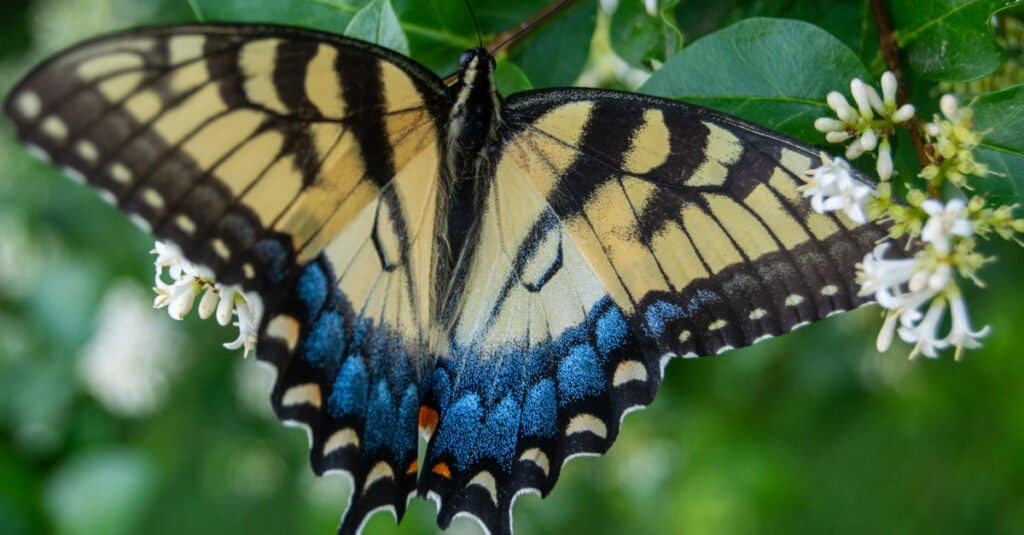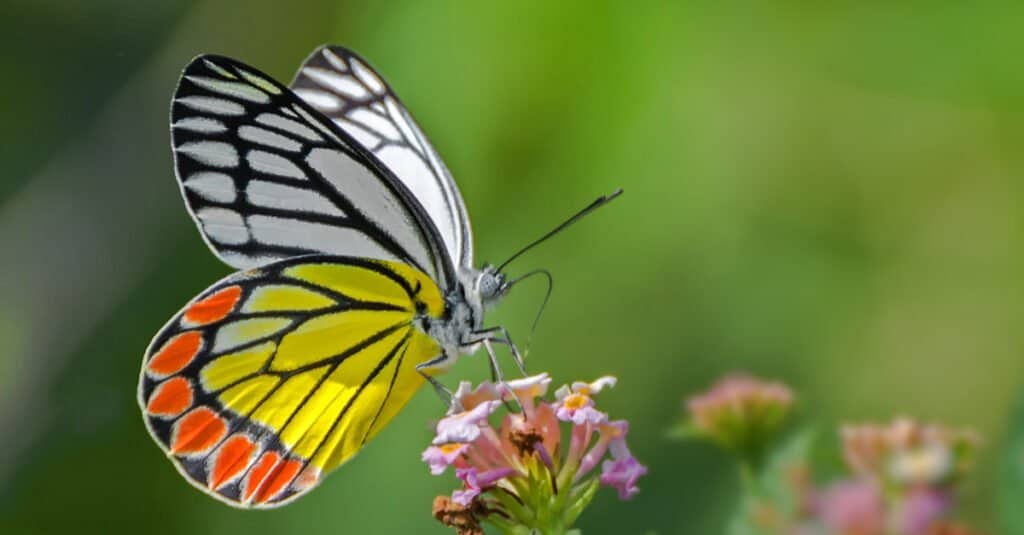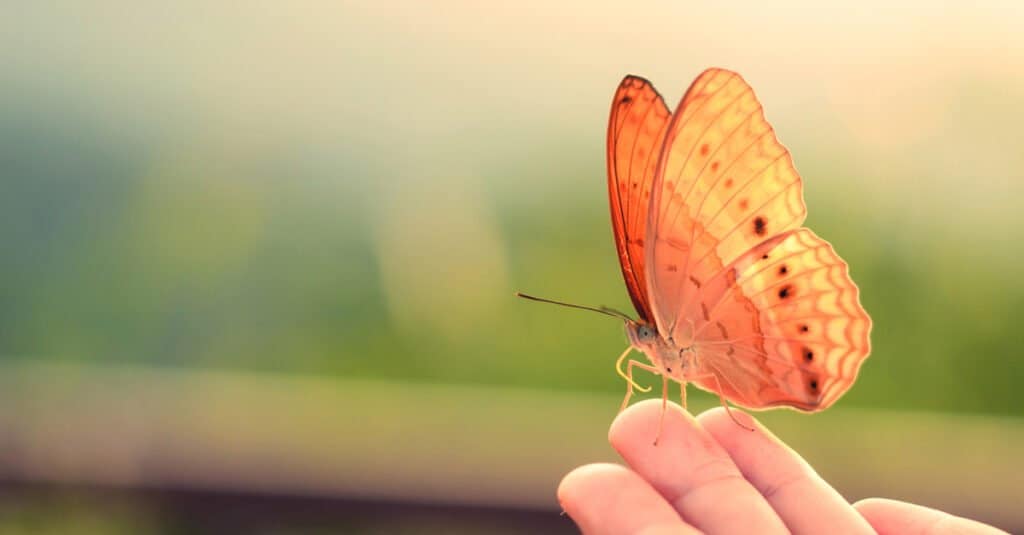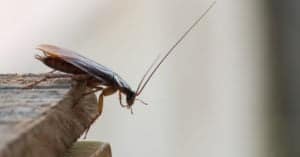Fear Of Butterflies: What’s It Called and Why Are Some People Scared of Butterflies?
Most of us consider butterflies some of nature’s most beautiful, graceful creations. We invite them into our gardens, plant flowers for them, and photograph them. For some people, however, these flying insects inspire nothing but anxiety and crippling fear. What causes this fear, and what can people do about it?
Fear of Butterflies is a Phobia

Neal Bryant/Shutterstock.com
In reality, fear of butterflies is a phobia. The name for it is lepidopterophobia (Lep-Ah-Dop-Ter-Ah-Pho-Bee-Ah). It means an irrational fear of butterflies or moths.
A phobia is defined as an extreme, irrational fear of something. People can develop phobias for many different things, including animals, situations, weather events, and specific places. People who suffer from phobia experience fear and dread, even if the object they fear is far away. Some people can’t even bear to see pictures of the thing they fear.
Symptoms of Phobia
People with severe phobias can experience symptoms from seeing the object, hearing about it, or seeing a picture of it. Common symptoms include:
- Shaking and crying
- Sense of panic
- Severe anxiety
- Insomnia
- Heart palpitations
- Shortness of breath
- Inability to focus
- Strong desire to run away
Phobias are a type of anxiety disorder. Severe phobias can interfere with a person’s ability to enjoy life.
Common Phobias
A surprisingly high number of people experience some type of phobia. An estimated 10 million people in the United States suffer from phobias. According to the National Institute of Mental Health, the most common phobias include:
- Glossophobia: Fear of speaking in public
- Arachnophobia: Fear of spiders
- Myctophobia: Fear of darkness
- Claustrophobia: Fear of enclosed spaces
- Acrophobia: Fear of heights
- Brontophobia: Fear of thunderstorms
Some common animal phobias include:
- Ailurophobia: Fear of cats
- Ophidiophobia: Fear of snakes
- Cynophobia: Fear of dogs
- Musophobia: Fear of mice
Is It Fear or Phobia?
You might say, “Many people are afraid of those things. Are we all suffering from phobias?”. The difference is that people with genuine phobias go beyond the slight fear or anxiety that you might feel about, for instance, getting on an airplane or being around certain bugs. People with phobias experience severe symptoms that can negatively affect their lives. The good news is that treatment for phobias is straightforward and quick.
What Causes Phobias?
Mental health experts are not sure what causes phobias to develop. In some cases, there is an obvious connection. Someone who was mauled by a dog when they were a child, for instance, might develop a lifelong, crippling fear of dogs. In other cases, genetic and environmental factors may contribute to the phobia. If you have a close relative who has a phobia, you are more likely to have one.
Some people experience a frightening encounter, for instance, with a cat, and then start to see terrifying cats on TV or in books. They start to hear from other people who are afraid of cats, and their first fear develops into a full-blown phobia.
People who have mental illnesses and chronic medical conditions are also more likely to experience phobias.
What Causes Lepidopterophobia?

Shubhrojyoti/Shutterstock.com
Lepidopterophobia can happen for similar reasons as any phobia. People might develop their fear of butterflies after seeing a butterfly while they were experiencing distress for some unrelated reason. Their mind may have fixed on the butterfly and associated it with their sense of dread or panic.
Consider another scenario. Someone who’s sleeping is terrified when they’re awakened by a butterfly landing on their face. That fear won’t go away, even though they know butterflies are harmless. If they don’t act on this fear, they will continue to be scared of butterflies, and that reaction will become fixed.
Although we’re not sure how they start, we know phobias can be cured. People can get over their fears and enjoy all of life’s wonderful creatures, even those that currently scare them silly.
Symptoms of Lepidopterophobia
Someone who has a phobia of butterflies might experience:
- Fear of seeing or touching butterflies
- Anxiety or panic when thinking or talking about them
- Staying away from places where they might see them
Psychologists diagnose a phobia when you’ve experienced these symptoms for six months or more.
Can Children Have Lepidopterophobia?
Children are often scared of insects and animals. In most cases, they outgrow these fears, especially once they spend time with these animals and learn they’re harmless.
If your child shows persistent, irrational fears of something, try these steps:
- Talk to them about their fears. Ask them to explain why they’re scared of butterflies and if something happened to cause those fears.
- Don’t tease or make fun of your child. Show that you understand their fears. Be reassuring and supportive.
- Don’t force your child to confront the object of their fear. Some people mistakenly think a child will “get over” their fear if you force them to “be brave.” This usually backfires. The best approach is to encourage them to be around butterflies and to praise them for every step they make toward overcoming their fear.
- Talk to their doctor. If your child’s fear is persistent, talk to their pediatrician. You may want to ask for a referral to a child psychotherapist.
Can Phobias Be Cured?
Yes, they can be cured. To find someone who can help, look for a psychotherapist who specializes in phobias and anxiety disorders.
Exposure and Desensitization
The most commonly used treatment for phobias is known as exposure and desensitization. It is a form of cognitive-behavioral therapy (CBT), which is a proven therapy for anxiety, panic disorders, and phobias.
In exposure therapy, you gradually increase your tolerance for butterflies. Your therapist begins by using relaxation techniques, including deep breathing, guided imagery, and hypnosis. Once you are completely calm, your therapist trains you in using these techniques when you meet a butterfly. During each treatment session, your therapist will first make sure you’re relaxed. Then, you might look at a picture of a butterfly while using your relaxation techniques. The next step might be watching a video of a butterfly. After that, you step up your exposure gradually. One day, you might tolerate seeing butterflies live. Later in therapy, you might be able to touch one without being afraid.
This therapy is simple, straightforward, and fairly quick. Many people can find relief from their phobias in under 10 sessions.
Group Therapy
Group therapy works for phobias. In this treatment, you meet other people who share your fear of butterflies. This provides peer support and can make it easier to face your fears. In group therapy, your psychotherapist is likely to use a group form of CBT or exposure therapy. For instance, your therapist’s goal may be to take your group to a butterfly farm or a field full of butterflies.
Family Therapy
If your family situation is making your fear of butterflies worse, family therapy may be in order. This is also useful for children who are scared of butterflies. Involving all family members in treatment enhances the chances of success.
How To Cope with Being Scared of Butterflies

Ake13bk/Shutterstock.com
You can practice relaxation techniques that help you cope with fear and anxiety related to butterflies. These techniques and self-care measures can help:
- Learn meditation. Meditation is a useful technique for everyone. If you have anxiety or phobias, it can help you stay focused and relaxed.
- Practice deep breathing. Slow down and practice deep breathing when you feel frightened.
- Get regular exercise. Exercise helps prevent symptoms of panic. It also helps you relieve stress.
- Avoid excessive caffeine. Too much caffeine can increase symptoms of anxiety and panic.
- Get regular sleep. Many people with anxiety disorders have difficulty sleeping. Focus on changing your habits to ensure you get a good night’s sleep.
- Join a support group. Support groups for anxiety or phobias can be very helpful, and many are free to join.
Let Go of Your Fear
Don’t be ashamed of your phobia. Many people have phobias of things you face fearlessly every day. Learning relaxation techniques and getting therapy can help you learn to appreciate butterflies.
More from A-Z Animals
Most of us consider butterflies some of nature’s most beautiful, graceful creations. We invite them into our gardens, plant flowers for them, and photograph them. For some people, however, these flying insects inspire nothing but anxiety and crippling fear. What causes this fear, and what can people do about it?
Fear of Butterflies is a Phobia

Neal Bryant/Shutterstock.com
In reality, fear of butterflies is a phobia. The name for it is lepidopterophobia (Lep-Ah-Dop-Ter-Ah-Pho-Bee-Ah). It means an irrational fear of butterflies or moths.
A phobia is defined as an extreme, irrational fear of something. People can develop phobias for many different things, including animals, situations, weather events, and specific places. People who suffer from phobia experience fear and dread, even if the object they fear is far away. Some people can’t even bear to see pictures of the thing they fear.
Symptoms of Phobia
People with severe phobias can experience symptoms from seeing the object, hearing about it, or seeing a picture of it. Common symptoms include:
- Shaking and crying
- Sense of panic
- Severe anxiety
- Insomnia
- Heart palpitations
- Shortness of breath
- Inability to focus
- Strong desire to run away
Phobias are a type of anxiety disorder. Severe phobias can interfere with a person’s ability to enjoy life.
Common Phobias
A surprisingly high number of people experience some type of phobia. An estimated 10 million people in the United States suffer from phobias. According to the National Institute of Mental Health, the most common phobias include:
- Glossophobia: Fear of speaking in public
- Arachnophobia: Fear of spiders
- Myctophobia: Fear of darkness
- Claustrophobia: Fear of enclosed spaces
- Acrophobia: Fear of heights
- Brontophobia: Fear of thunderstorms
Some common animal phobias include:
- Ailurophobia: Fear of cats
- Ophidiophobia: Fear of snakes
- Cynophobia: Fear of dogs
- Musophobia: Fear of mice
Is It Fear or Phobia?
You might say, “Many people are afraid of those things. Are we all suffering from phobias?”. The difference is that people with genuine phobias go beyond the slight fear or anxiety that you might feel about, for instance, getting on an airplane or being around certain bugs. People with phobias experience severe symptoms that can negatively affect their lives. The good news is that treatment for phobias is straightforward and quick.
What Causes Phobias?
Mental health experts are not sure what causes phobias to develop. In some cases, there is an obvious connection. Someone who was mauled by a dog when they were a child, for instance, might develop a lifelong, crippling fear of dogs. In other cases, genetic and environmental factors may contribute to the phobia. If you have a close relative who has a phobia, you are more likely to have one.
Some people experience a frightening encounter, for instance, with a cat, and then start to see terrifying cats on TV or in books. They start to hear from other people who are afraid of cats, and their first fear develops into a full-blown phobia.
People who have mental illnesses and chronic medical conditions are also more likely to experience phobias.
What Causes Lepidopterophobia?

Shubhrojyoti/Shutterstock.com
Lepidopterophobia can happen for similar reasons as any phobia. People might develop their fear of butterflies after seeing a butterfly while they were experiencing distress for some unrelated reason. Their mind may have fixed on the butterfly and associated it with their sense of dread or panic.
Consider another scenario. Someone who’s sleeping is terrified when they’re awakened by a butterfly landing on their face. That fear won’t go away, even though they know butterflies are harmless. If they don’t act on this fear, they will continue to be scared of butterflies, and that reaction will become fixed.
Although we’re not sure how they start, we know phobias can be cured. People can get over their fears and enjoy all of life’s wonderful creatures, even those that currently scare them silly.
Symptoms of Lepidopterophobia
Someone who has a phobia of butterflies might experience:
- Fear of seeing or touching butterflies
- Anxiety or panic when thinking or talking about them
- Staying away from places where they might see them
Psychologists diagnose a phobia when you’ve experienced these symptoms for six months or more.
Can Children Have Lepidopterophobia?
Children are often scared of insects and animals. In most cases, they outgrow these fears, especially once they spend time with these animals and learn they’re harmless.
If your child shows persistent, irrational fears of something, try these steps:
- Talk to them about their fears. Ask them to explain why they’re scared of butterflies and if something happened to cause those fears.
- Don’t tease or make fun of your child. Show that you understand their fears. Be reassuring and supportive.
- Don’t force your child to confront the object of their fear. Some people mistakenly think a child will “get over” their fear if you force them to “be brave.” This usually backfires. The best approach is to encourage them to be around butterflies and to praise them for every step they make toward overcoming their fear.
- Talk to their doctor. If your child’s fear is persistent, talk to their pediatrician. You may want to ask for a referral to a child psychotherapist.
Can Phobias Be Cured?
Yes, they can be cured. To find someone who can help, look for a psychotherapist who specializes in phobias and anxiety disorders.
Exposure and Desensitization
The most commonly used treatment for phobias is known as exposure and desensitization. It is a form of cognitive-behavioral therapy (CBT), which is a proven therapy for anxiety, panic disorders, and phobias.
In exposure therapy, you gradually increase your tolerance for butterflies. Your therapist begins by using relaxation techniques, including deep breathing, guided imagery, and hypnosis. Once you are completely calm, your therapist trains you in using these techniques when you meet a butterfly. During each treatment session, your therapist will first make sure you’re relaxed. Then, you might look at a picture of a butterfly while using your relaxation techniques. The next step might be watching a video of a butterfly. After that, you step up your exposure gradually. One day, you might tolerate seeing butterflies live. Later in therapy, you might be able to touch one without being afraid.
This therapy is simple, straightforward, and fairly quick. Many people can find relief from their phobias in under 10 sessions.
Group Therapy
Group therapy works for phobias. In this treatment, you meet other people who share your fear of butterflies. This provides peer support and can make it easier to face your fears. In group therapy, your psychotherapist is likely to use a group form of CBT or exposure therapy. For instance, your therapist’s goal may be to take your group to a butterfly farm or a field full of butterflies.
Family Therapy
If your family situation is making your fear of butterflies worse, family therapy may be in order. This is also useful for children who are scared of butterflies. Involving all family members in treatment enhances the chances of success.
How To Cope with Being Scared of Butterflies

Ake13bk/Shutterstock.com
You can practice relaxation techniques that help you cope with fear and anxiety related to butterflies. These techniques and self-care measures can help:
- Learn meditation. Meditation is a useful technique for everyone. If you have anxiety or phobias, it can help you stay focused and relaxed.
- Practice deep breathing. Slow down and practice deep breathing when you feel frightened.
- Get regular exercise. Exercise helps prevent symptoms of panic. It also helps you relieve stress.
- Avoid excessive caffeine. Too much caffeine can increase symptoms of anxiety and panic.
- Get regular sleep. Many people with anxiety disorders have difficulty sleeping. Focus on changing your habits to ensure you get a good night’s sleep.
- Join a support group. Support groups for anxiety or phobias can be very helpful, and many are free to join.
Let Go of Your Fear
Don’t be ashamed of your phobia. Many people have phobias of things you face fearlessly every day. Learning relaxation techniques and getting therapy can help you learn to appreciate butterflies.






